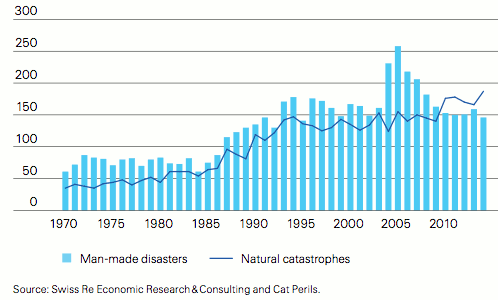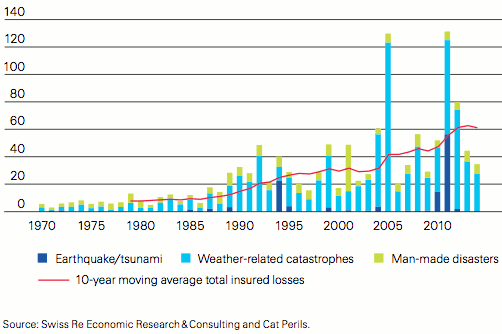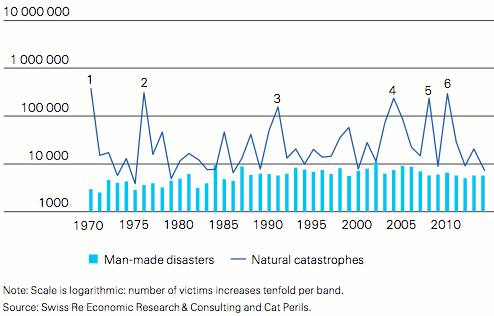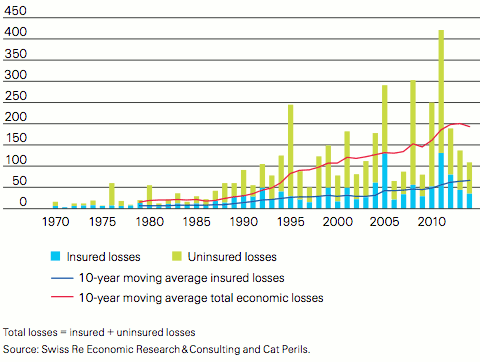2014 saw the highest number of natural catastrophe events that global reinsurance firm Swiss Re’s sigma unit has ever recorded, but despite the increasing frequency of loss events, the impact to insurance and reinsurance markets was below average.
Swiss Re recorded 189 natural catastrophe events worldwide in 2014, the highest since its sigma records began. However these 189 catastrophe loss events only resulted in insured losses of $28 billion, according to the numbers released today.

Number of catastrophe and man-made disaster events - Source: Swiss Re
The latest sigma report looks at both natural catastrophe and man-made disaster losses during 2014 and finds that the overall toll and losses borne by insurers and reinsurers remained well below the ten-year average.
In total Swiss Re’s report counts $110 billion of global economic losses from natural catastrophes and man-made disasters, down from $138 billion in 2013 and well below the ten-year average of $200 billion. $101 billion of the economic losses were due to natural catastrophe events, which Asia Pacific cyclones causing the bulk of these financial losses.
This translates into $35 billion of insurance industry losses, down from $44 billion in 2013 and significantly below the ten-year average for insured losses at $64 billion.

Insured catastrophe losses, 1970–2014, in USD billion at 2014 prices - Source: Swiss Re
Also down were lives lost due to catastrophes and disasters, with 12,700 lives lost in 2014, less than half the 27,000 thought to have been lost in 2013. This is one of the lowest numbers of lives lost in a single year in Swiss Re’s records.

Lives lost from catastrophes and man-made disasters - Source: Swiss Re
Weather losses caused the bulk of the impact to the insurance and reinsurance industry, particularly in the U.S., Europe and Japan.
“The frequency of catastrophic events appear to be increasing, with a record number of natural catastrophes last year,” commented Kurt Karl, Swiss Re’s Chief Economist.
Swiss Re cites the following as key weather and natural catastrophe events that caused insured losses during 2014:
For example, a series of severe thunderstorms triggered sizable losses in both the US and Europe last year. In May, a spate of severe storms with hail in the US resulted in the largest insured loss event of the year, with insurance claims of USD 2.9 billion.
In Europe in the following month, the low pressure system Ela brought large and damaging hail to parts of France and Belgium, and strong winds in Germany. The combined insured losses were USD 2.2 billion, making Ela the second most expensive hail event in Europe on sigma records.
Harsh winters in the US and in Japan were another major cause of insurance claims in 2014. The US experienced multiple storms with heavy snow and long stretches of freezing temperatures. Insured losses from all winter storms in the US were USD 2.4 billion, more than double the average of the previous 10 years. The largest loss event was a storm in January that impacted 17 states, with snow falling as far south as Florida, leading to overall insured losses of USD 1.7 billion. Meanwhile in Japan, a severe cold snap in mid-February brought the heaviest snow in decades, killing 26 people and injuring many more, primarily in road accidents. The insured loss total was estimated at USD 2.5 billion.
It was another quiet hurricane season in the North Atlantic in 2014, with no major hurricane making US landfall for the ninth year in succession. This was the main reason for the overall below-average insured losses last year. In contrast, there were 20 named storms in the eastern Pacific, the most since 1992. Of those, in September Hurricane Odile in the Baja of California, Mexico, caused the biggest event loss. The region is a tourist destination with many hotels and commercial properties and consequently, insurance penetration is relatively high. The insured losses were USD 1.7 billion, making Odile the second largest insured loss event ever in Mexico, after Hurricane Wilma in 2005 which caused insured losses of USD 2.1 billion.
Swiss Re highlights the gap between economic and insured losses as a continuing issue, demonstrated once again by many catastrophe losses which are virtually uninsured. Note the steady expansion of the gap between insured and uninsured losses over the last few decades.

Insured vs uninsured losses, 1970–2014, in USD billion in 2014 prices - Source: Swiss Re
The reinsurer explains:
For example, in May, low pressure system Yvette brought very heavy rain to Serbia, Bosnia and Croatia, in some areas the heaviest downpour in 120 years. Several dams failed and the ensuing floods and debris flows destroyed houses, infrastructure and crops. There were 82 deaths, the largest loss of life from a natural catastrophe event in Europe in 2014, and total losses were estimated to be USD 3 billion, mostly uninsured. Italy also endured a very wet year, with a series of flash floods events causing overall economic losses of more than USD 1 billion, also largely uninsured.
There are areas which are underinsured in the US also. In August last year, the South Napa earthquake caused structural and inventory damage totalling USD 0.7 billion, particularly in the numerous barrel storage facilities of the local wine industry. However, the insured loss was just USD 0.16 billion. “In spite of high exposure to seismic risk, insurance take-up in San Francisco County and California state generally is still very low, even for commercial properties. That’s why insured losses, in certain areas, can be surprisingly low when disaster events happen,” says Lucia Bevere, co-author of the study.
Once again losses from severe thunderstorms are highlighted as a peril which is experiencing a particularly upwards trend in recent years. Swiss Re believes that both economic costs and insured losses from severe thunderstorms have been on the rise for 25 years now, mainly due to rising losses in the U.S. and Europe, where insurance penetration is highest.
Global insured losses from severe convective storms (so thunderstorm, tornado and hail events) rose by an average annual rate of 9% between 1990 and 2014, according to Swiss Re’s numbers. Insured losses from all-weather events in the same period rose by 6.6% on the same basis, showing that convective weather is outpacing other weather related losses.
In the US insured losses from severe convective storms averaged $8 billion per year between 1990 and 2014. After 2008, those losses have risen again to exceed $10 billion per year, including in 2014 when insured losses were $13 billion, the fourth highest that Swiss Re’s sigma has recorded.
Swiss Re’s latest sigma report once again demonstrates the dip in catastrophe losses witnessed in recent years, which has been exacerbating the excess capital issues in the reinsurance market. However it also demonstrates the opportunity to put some of this capital to work in narrowing the gap between economic and insured losses, while also better protecting against increasing convective losses.
The insurance, reinsurance and capital markets all have work to do in narrowing the gap and ensuring that more of the economic exposures are covered by risk transfer and financing products.
You can access Swiss Re’s latest sigma report here.
 View all of our Artemis Live video interviews and subscribe to our podcast.
View all of our Artemis Live video interviews and subscribe to our podcast.
All of our Artemis Live insurance-linked securities (ILS), catastrophe bonds and reinsurance video content and video interviews can be accessed online.
Our Artemis Live podcast can be subscribed to using the typical podcast services providers, including Apple, Google, Spotify and more.































